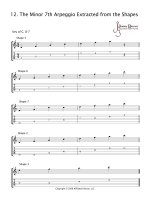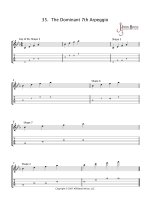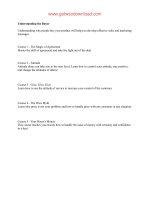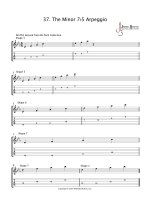The adaptic water management tủ tài liệu bách khoa
Bạn đang xem bản rút gọn của tài liệu. Xem và tải ngay bản đầy đủ của tài liệu tại đây (1.8 MB, 217 trang )
234x156 cover (240x159mm with the 3mm bleed) ppc
flooding, drought, maintaining biodiversity and ecological functions and services, in a context where
human beliefs, actions and values play a central role. Furthermore, the growing uncertainties of
global climate change and the long term implications of management actions make the problems
even more difficult.
This book explains the benefits, outcomes and lessons learned from adaptive water management
(AWM). In essence AWM is a way of responding to uncertainty by designing policy measures which
are provisional and incremental, subject to subsequent modification in response to environmental
change and other variables. Included are illustrative case studies from seven river basins from across
Europe, West Asia and Africa: the Elbe, Rhine, Guadiana, Tisza, Orange, Nile and Amudarya. These
exemplify the key challenges of adaptive water management, especially when rivers cross national
boundaries, creating additional problems of governance.
Jaroslav Mysiak is Senior Researcher at the Fondazione Eni Enrico Mattei, and a lecturer at the
Department of Economics, University Ca’Foscari in Venice, Italy. Hans Jørgen Henriksen is Senior
Advisor in Hydrology at the Geological Survey of Denmark and Greenland, GEUS, Copenhagen,
Denmark.Caroline Sullivan is an environmental economist and is currently Group Leader of the
Water Management and Policy Group at the Oxford University Centre for the Environment, UK.
John Bromley is a hydrogeologist and a Senior Research Fellow at the Oxford University Centre for
Water Research, UK. Claudia Pahl-Wostl is Professor of Management of Resource Flows at the
Based on extensive collaborative research from the NeWater (New Approaches to Adaptive Water
Management Under Uncertainty) project.
www.earthscan.co.uk
Earthscan strives to minimize its impact on the environment
9 781844 077922
Edited by
ISBN 978-1-84407-792-2
‘Libya’ © Tobias Helbig/istockphoto.com
contract no 511179 (GOCE)
The
Adaptive Water
Resource
Management
Handbook
Mysiak, Henrikson,
Sullivan, Bromley
and Pahl-Wostl
Climate Change/Risk and Science & Technology Studies/Water
‘African Home’ © Peeter Viisimaa/istockphoto.com
Institute for Environmental Systems Research in Osnabruck, Germany.
The Adaptive Water Resource Management Handbook
need to solve a range of interrelated water dilemmas, such as balancing water quantity and quality,
Front cover photos (left to right): ‘How to Get Your Water’ © Klaas Lingbeek- van Kranen/istockphoto.com
The complexity of current water resource management poses many challenges. Water managers
spine 21.1mm
Edited by Jaroslav Mysiak, Hans Jorgen Henrikson,
Caroline Sullivan, John Bromley and Claudia Pahl-Wostl
The Adaptive Water Resource
Management Handbook
The Adaptive Water Resource
Management Handbook
Edited by Jaroslav Mysiak, Hans Jørgen Henrikson,
Caroline Sullivan, John Bromley and
Claudia Pahl-Wostl
London • Sterling, VA
First published by Earthscan in the UK and USA in 2010
Copyright © Dr Jaroslav Mysiak, 2010
All rights reserved
ISBN: 978-1-84407-792-2
Typeset by Hands Fotoset, Nottingham, UK
Cover design by Yvonne Booth
For a full list of publications please contact:
Earthscan
Dunstan House
14a St Cross St
London, EC1N 8XA, UK
Tel: +44 (0)20 7841 1930
Fax: +44 (0)20 7242 1474
Email:
Web: www.earthscan.co.uk
22883 Quicksilver Drive, Sterling, VA 20166-2012, USA
Earthscan publishes in association with the International Institute for
Environment and Development
A catalogue record for this book is available from the British Library
Library of Congress Cataloging-in-Publication Data
The adaptive water resource management handbook / edited by
Jaroslav Mysiak ... [et al.].
p. cm.
Includes bibliographical references and index.
ISBN 978-1-84407-792-2 (hardback)
1. Water–Distribution–Planning–Handbooks, manuals, etc. 2.
Water-supply engineering–Handbooks, manuals, etc. 3. Adaptive
natural resource management–Handbooks, manuals, etc. 4. Water
resources development–Government policy–Case studies. I. Mysiak,
Jaroslav.
TD345.A335 2009
628.1–dc22
2009014036
At Earthscan we strive to minimize our
environmental impacts and carbon footprint
through reducing waste, recycling and offsetting
our CO2 emissions, including those created
through publication of this book.
For more details of our environmental policy,
see www.earthscan.co.uk.
This book was printed in the UK by Cromwell Press.
The paper used is FSC certified and the inks are
vegetable based.
Contents
List of Figures and Tables
Contributor Affiliations
List of Acronyms and Abbreviations
1
Introduction – Making a Strong Case for AWM
1
1.1 Challenges of river basin management
C.A. Sullivan (2, 33)
1
1.2 Integrated Water Resources Management (IWRM)
P. van der Keur (3) and G.J. Lloyd (4)
4
1.3 Adaptive Water Management in terms of development and
application within IWRM
P. van der Keur (3), P. Jeffrey (6), D. Boyce (6),
C. Pahl-Wostl (1), A.C. Hall (7) and G.J. Lloyd (4)
1.4 Tools for adaptive management
J. Bromley (2) and J. Mysiak (5)
2
xi
xiii
xv
7
9
1.5 AWM concept in terms of training and capacity building
S. Rotter (14), D. Ridder (14) and P. van der Keur (3)
11
Working Towards AWM
H. Jørgen Henriksen (3), J. Mysiak (5), F. Jaspers (9),
R. Giordano (8), C.A. Sullivan (2, 33) and J. Bromley (2)
17
2.1 Key outcomes and benefits of AWM
17
2.2 Summary of outcomes from NeWater case river basins
(outputs and benefits)
22
2.3 Experiences and identification of lessons learned from
piloting AWM
32
vi
3
THE ADAPTIVE WATER RESOURCE MANAGEMENT HANDBOOK
Tools and Instruments for Adaptive Management
33
3.1 Management of participatory processes
D. Ridder (14), S. Rotter (14), E. Mostert (10), N. Isendahl (1)
and D. Hirsch (1)
33
3.2 Participatory modelling
J. Sendzimir (15), P. Magnuszewski (15), O. Barreteau (16),
N. Ferrand (16), K. Daniell (16) and D. Haase (17)
39
3.3 Uncertainty and policy making
M. Brunach (1), P. van der Keur (3) and J. Mysiak (5)
43
3.4 Indicators and monitoring to support AWM
C.S. Sullivan (2,33), C. Giupponi (5) and R. Giordano (8)
47
3.5 An introduction to analysing dynamic vulnerability
S. Bharwani (18), J. Hinkel (12), T. Downing (18)
and R. Taylor (18)
53
3.6 Integrated assessment tools and decision support systems
C. Giupponi (5) and P. Walsum (9)
57
3.7 Climate change impacts on water resources and adaptation
options
V. Krysanova (12) and F. Hattermann (12)
4
62
3.8 Management and Transition Framework
C. Pahl Wostl (1), B. Kastens (1) and C. Knieper (1)
67
3.9 Internet portals and services for knowledge transfer
C. Knieper (1), D. Thalmeinerova (7) and J. Mysiak (5)
70
Capacity Building and Knowledge Transfer
81
S. Rotter (14), C. Terwisscha Van Scheltinga (9), C. van Bers (1),
D. Ridder (14), F. Jaspers (9) and P. van der Keur
4.1 Introduction
81
4.2 Aims of the training courses
81
4.3 Target audience for training
82
4.4 Obstacles encountered
82
4.5 The ‘broker concept’
82
4.6 Train-the-trainer workshops
83
4.7 Train-the-practitioner workshops
83
4.8 AWM in academic education
84
CONTENTS
5
6
7
vii
4.9 Lessons learned in academic education
85
4.10 Involvement of organizations outside the project consortium
86
Case Study: Elbe
V. Krysanova (12), C. Hesse (12), M. Martínková (19),
R. Koskova (20) and S. Blazkova (19)
89
5.1 Background
89
5.2 Selected themes
90
5.3 Research and tools applied in the Elbe case study
93
5.4 Outlook and policy summary
98
Case Study: Guadiana
R.M. Llamas (21), C. Varela-Ortega (31), A. de la Hera (13),
M.M. Aldaya (21), F. Villarroya (21), P. Martínez-Santos (21),
I. Blanco (31), G. Carmona (31), P. Esteve (31), L. De Stefano (21),
N. Hernández-Mora (21) and P. Zorrilla (21)
103
6.1 Background
103
6.2 Selected themes
104
6.3 Groundwater modelling and management scenarios
109
6.4 WEAP model
109
6.5 The vulnerability analysis (CART analysis)
110
6.6 Bayesian Belief Networks
110
6.7 Water Footprint
111
6.8 The Future
112
Case Study: Rhine
J.G. Timmerman (22), H. Buiteveld (22), M. Lamers (23),
S. Möllenkamp (1), N. Isendahl (1), B. Ottow (28) and
T. Raadgever (10)
117
7.1 Introduction
117
7.2 The Lower Rhine
118
7.3 Kromme Rijn
120
7.4 Wupper
123
7.5 Comparison between the Wupper and Kromme Rijn regimes
125
viii
8
9
THE ADAPTIVE WATER RESOURCE MANAGEMENT HANDBOOK
7.6 Conclusions
126
Case Study: Tisza
D. Haase (17), S. Bharwani (18), S. Kuptsova (29) and
A. Iaroshevitch (30)
129
8.1 Background
129
8.2 Major problems
130
8.3 Lessons learnt and the future
139
8.4 How can AWRM help and what tools are still needed
140
Case Study: Amudarya
M. Schlüter (17), D. Hirsch (1), U. Abdullaev (35),
E. Herrfahrdt-Pähle (24), R. Giordano (8), M. Khamirzaeva 26),
G. Khasankhanova (35), N. Kranz (25), S. Liersch (17),
N. Matin (18), A. Salokhiddinov (26), A. Savitsky (26),
C. Siderius (9) and R. Toryannikova (36)
143
9.1 Background
143
9.2 Selected themes addressed in the Amudarya Case Study
144
9.3 Tools developed and applied in the Amudarya case study
151
9.4 The future
154
10 Case Study: Nile
C.W.J. (Koen) Roest (9), O. Schoumans (9), C. Siderius (9),
P. van Walsum (9) and F. Jaspers (9)
157
10.1 Background
157
10.2 Selected themes in the NeWater project
160
10.3 Tools applied in NeWater
160
10.4 Future of the Nile Basin
167
11 Case Study: Orange
169
C.A. Sullivan (2,33), C. Dickens (27), M. Mander (34),
M. Bonjean (2), D. Macfarlane (27), S. Bharwani (18), N. Matin (18),
K. Pringle (27), N. Diederichs (34), A. Taylor (18), M. Shale (18),
C. King-Okumu (2), C.N. Kranz (25), S. Bisaro (12), A. Zabala (2),
A. Romero (2), P. Huntjens (1) and D. Knoesen (27)
11.1 Background
169
CONTENTS
ix
11.2 Addressing issues of concern
170
11.3 The institutional context in the Orange basin
171
11.4 Tools and approaches applied in the Orange-Senqu case study
171
11.5 Theme 1: A focus on ecosystem goods and services
172
11.6 Theme 2: Investigating alternative possible futures through
scenarios
176
11.7 Conclusion
180
12 Summary and Outlook
H. Jørgen Henriksen (3), J. Mysiak (5), C.A. Sullivan (2,33),
J. Bromley (2) and C. Pahl-Wostl (1)
183
12.1 What is adaptive management and why it matters
183
12.2 How AWM can contribute to implementation of water policies 185
12.3 Lessons learned and practical suggestions
Index
187
193
List of Figures and Tables
Figures
1.1
2.1
The IWRM cycle
Examples of short-, medium- and long-term outcomes of the
AWM practices in relation to overarching goals of natural resource
management and principles of environmental governance
2.2 Seven NeWater case studies
2.3 Five metaphors and lessons learning from piloting AWM in
NeWater case studies
3.4.1 Conceptual architecture of the Adaptive Monitoring Information
System (AMIS) Source: Giordano et al. (2008)
3.5.1 The dynamic and transient nature of vulnerability
3.8.1 Schematic representation of important elements in the water system
3.8.2 Policy cycle and learning cycles connected to MTF. The processes
take place at several levels (e.g. provincial – basin – national) and
are far more iterative than the relatively schematic representation
might suggest
3.9.1 Illustration of social learning in WISE-RTD’s new AWM section
3.9.2 Selection of basic NeWater results in the partner section of the
GWP Toolbox
5.1 The Elbe River basin
5.2 The ‘simulation control centre’ discusses the results
5.3 Changes in water discharge, nutrient concentrations and loads
according to land use/land management scenarios
6.1 Map of the Guadiana river basin
8.1 Variables which affect decisions
8.2 Game designed for VCHs
8.3 Decision-making rules from the KnETs game
9.1 The Amudarya river basin in Central Asia
9.2 Combined cognitive models for soil salinity assessment. HE =
Hydromeliorative Expedition, GIS = Geographic Information
System, WUA = Water User Association
6
19
22
34
52
55
68
70
73
74
90
96
97
104
104
137
138
144
147
xii
THE ADAPTIVE WATER RESOURCE MANAGEMENT HANDBOOK
9.3
Modflow-Simgro Amudarya model output for the whole
Amudarya delta
Erosion risk map for the Lake Victoria region
Evolution of income for Rwanda and for the Nile Basin as a result
of investment level and different priorities
The Orange River Basin in Southern Africa, and wetland study
sites in the upper basin
An output from the WET-Ecoservices tool describing a valley
bottom wetland in the Lesotho Highlands, and an illustration
of the costs associated with water quality improvements in a
wetland system in Gauteng
Water Vulnerability Index Scores, South Africa, 2008
The double loop learning cycle with regular planning and learning
cycles
Metaphors and lessons learning from piloting AWM in NeWater
case studies
10.1
10.2
11.1
11.2
11.3
12.1
12.2
154
162
165
170
173
177
184
187
Tables
2.1
2.2
2.3
3.1
Catalysts of adaptive management
Examples of AWM outcomes (outputs and benefits of AWM)
Overview of AWM properties and issues in case studies
General Rules for implementing Participatory Modelling (PM)
that involves collaboration between stakeholders (SH)
(after van den Belt, 2004)
3.6.1 Main characteristics of the DSS tools examined (abbreviated list
from Giupponi et al., 2007)
3.6.2 Steps in the implementation and customization of a DSS tool
8.1 Key water challenges
8.2 Methodological Design
8.3 Analysis of the GMB process
10.1 Priority environmental threats by country
10.2 Overview of priorities in adaptation options (iiiiii = high priority)
11.1 Themes and tools applied in the Orange Senqu case study
11.3 Selected example values of wetland benefits in the Orange
Senqu basin
20
20
21
42
60
62
130
133
134
161
164
172
175
Contributor Affiliations
1
2
3
4
5
6
7
8
9
10
11
12
13
Institute of Environmental Systems Research, University of Osnabrück,
Barbarastrasse 12, 49069 Osnabrück, Germany
Oxford University School of Geography and the Environment, South Parks
Road, Oxford OX1 3QY, United Kingdom
Geological Service of Denmark & Greenland, Øster Voldgade 10, 1350
Kopenhagen, Denmark
DHI Water Policy – Governance for sustainable development, Agern Allé 5,
DK-2970 Hørsholm, Denmark
Fondazione Eni Enrico Mattei, Castello 5252, 30122 Venice, Italy
Cranfield University, Cranfield, Bedfordshire MK43 0AL, United Kingdom
Global Water Partnership, Drottninggatan 33, SE-111 51 Stockholm,
Sweden
Water Research Institute of National Research Council, Via De Blasio, 5 –
70123 Bari, Italy
ALTERRA – Wageningen University and Research Centre, Droevendaalsersteeg 3, 6700 AA Wageningen, The Netherlands
RBA, Technical University Delft, PO Box 5048, NL-2600 GA Delft, The
Netherlands
University of Exeter, The Queen’s Drive, Exeter, Devon EX4 4QJ, United
Kingdom
Potsdam Institute for Climate Impact Research, Telegrafenberg A 31,
14473 Potsdam, Germany
Geological Survey of Spain/Instituto Geológico y Minero de España
(IGME). Ríos Rosas 23. 28003 Madrid, Spain
xiv
THE ADAPTIVE WATER RESOURCE MANAGEMENT HANDBOOK
14 SEECON, Westerbreite 7, 49084 Osnabrück, Germany
15 International Institute of Applied Systems Analysis, Schlossplatz 1, A-2361
Laxenburg, Austria
16 Cemagref, Parc de Tourvoie, BP 44, F 92163 Antony Cedex, France
17 Helmholtz Centre for Environmental Research - UFZ, Permoserstraße 15,
04318 Leipzig, Germany
18 Stockholm Environmental Institute – Oxford Office Institute, Heslington,
York Y010 5DD, United Kingdom
19 T.G. Masaryk Water Research Institute, Prague 6, Podbabska 30, 160 62,
Czech Republic
20 Institute of Hydrodynamics, Academy of Sciences of the Czech Republic,
Pod Pa ankou 30/5, 166 12 Prague 6, Czech Republic
21 Geodynamics Department, Faculty of Geological Sciences, Complutense
University of Madrid, Jose Antonio Novais 2, 28040 Madrid, Spain
22 Rijkswaterstaat Centre for Water Management, PO Box 17, 8200 AA
Lelystad, The Netherlands
23 International Center for Integrative Studies, University Maastricht, 6211
CJ Maastricht, The Netherlands
24 German Development Institute, Tulpenfeld 6, 53113 Bonn, Germany
25 Ecologic Institute for International & European Environmental Policy,
Pfalzburger Strasse 43/44, D – 10717 Berlin, Germany
26 Tashkent Institute of Irrigation and Melioration, 39 Qory Niyoziy Street,
700000 Tashkent, Uzbekistan
27 Institute of Natural Resources, 67 St Patricks Road, P O Box 100396,
Scottsville, 3209, South Africa
28 Deltares, PO Box 85467, 3508 AL Utrecht, The Netherlands
29 Zacarpathian Water Board, Slavyanska Naberezhna, 5, 88018 Uzhgorod,
Ukraine
30 Ukrainian Water Consulting, Schekavytska St. 7/10, room.3, Kiev, Ukraine
31 Department of Agricultural Economics, Universidad Politécnica de Madrid,
ETS Ingenieros Agrónomos, Avenida Complutense s/n, 28040 Madrid,
Spain
32 Design and Research Institute of the Uzbek Ministry of Agriculture and
Water Resources, Tashkent, Uzbekistan
33 School of Environmental Science and Management, Southern Cross
University, New South Wales, Australia
34 Futureworks! PO Box, Everton 3625, South Africa
35 UZGIP (Uzgipromeliovodkhoz) Institute of the Ministry of Agriculture and
Water Resources, 44 Navoiy Street, Tashkent, 700011, Uzbekistan
36 Research Hydrometeorological Institute (NIGMI) of the Center of
Hydrometeorological Service at the Cabinet of Ministers of the Republic of
Uzbekistan
List of Acronyms and
Abbreviations
AM
AMIS
AWM
BBN
CART
CCM
DA
DPSIR
DSS
DWAF
EC
EDMI
EEA
EU
FRD
GCM
GMB
GVA
GWP
GWSP
HDSR
IAM
ICPE
ICPR
IPCC
ISD
IWRM
Adaptive Management
Adaptive Monitoring Information System
Adaptive Water Management
Bayesian Belief Networks
Classification and Regression Trees, Salford Systems
conceptual and cognitive modelling
decision analysis
Driving Pressure State Impact and Response Model
decision support system
Department of Water Affairs and Forestry
European Commission
Egalitarian Decision-Making Indexes
European Environmental Agency
European Union
Flood Risk Directive
General Circulation Model
Group Model Building
Gross Value Added
Global Water Partnership
Global Water System Project
Hoogheemraadschap De Stichtse Rijnlanden
Integrated Assessment and Modelling
International Commission for the Protection of the Elbe
International Commission for the Protection of the Rhine
Intergovernmental Panel on Climate Change
Indicators of Sustainable Development
Integrated Water Resources Management
xvi
THE ADAPTIVE WATER RESOURCE MANAGEMENT HANDBOOK
KnETs
LHDA
LUA
MGP
MP
MTF
NAPAs
NBI
NeWater
Knowledge Elicitation Tools
Lesotho Highlands Development Authority
Environmental Agency of Brandenburg
Mathematical Goal Programming
Mathematical Programming
Management and Transition Framework
National Adaptation Programs of Action
Nile Basin Initiative
New Approaches to Adaptive Water Management Under
Uncertainty
NL
The Netherlands
NWR
North Rhine-Westphalia
PA
Participation and Awareness
PEAG
Plan Especial del Alto Guadiana
PM
participatory modelling
PRUDENCE Prediction of Regional Scenarios and Uncertainties for Defining
European Climate change risks and effects)
RCM
regional climate model
RTD
Research and Technological Development
SANBI
South African National Biodiversity Institute
SEPA
Sidestream Elevated Pool Aeration
SIDA
Swedish International Development Agency
SWIM
Soil and Water Integrated Model
TMLNU
Thuringian Ministry of Agriculture, Nature Protection and
Environment
TRB
Tisza River Basin
TWQR
Target Water Quality Range
UGB
Upper Guadiana Basin
UNCED
UN Conference on Environment and Development
UNDP
United Nations Development Program
UPM
Technical University of Madrid
VCH
village council heads
WAP
Water Abstraction Plan
WEAP
Water Evaluation and Planning
WFD
Water Framework Directive
WISE
Water Information System for Europe
WPIS
web portal input system
WUAs
Water User Associations
WVI
Water Vulnerability Index
1
Introduction: Making a
Strong Case for AWM
1.1 Challenges of river basin management
C.A. Sullivan
Of the estimated 1.4 billion km3 of water in the world (Maidment, 1992), only
about 2.5 per cent of that is freshwater, with just a fraction actually accessible
by humans. In most places, water does not arrive where, or when, it is needed.
Only about 40 per cent of all rainfall enters our river systems, equating to some
40,000km3 of water per year.
Water resources of the Earth are part of a finite closed system and, in any
time period when human populations are rising, the per capita amount of water
available is inevitably decreasing. Added to this, as economies grow, the level of
water consumption increases, and in today’s world, those economies that are
growing the fastest also happen to be those with the largest populations (India
and China). This explains why it is likely that global water stress is likely to
increase at an exponential rate.
In the face of this increasing pressure, it is increasingly recognized that this
relatively small amount of water must currently be shared, not only by the huge
number of humans depending on it, but by all other terrestrial species as well.
In addition to this, society is increasingly faced with situations where the availability of water is limited by its quality, a consequence of our long history of
neglect of this precious resource. While developed countries now struggle to
address this changing view, increasing degradation of water bodes goes on
across the globe. In Europe, the EU Water Framework Directive (EC, 2000) has
been put in place as a mechanism to ensure human actions will no longer have
2
THE ADAPTIVE WATER RESOURCE MANAGEMENT HANDBOOK
an irreversible impact on the services provided by life-supporting ecosystems,
and similar efforts have taken place in Australia (Heaney and Beare, 2001) and
South Africa (Rowlston and Palmer, 2002).
Securing ecological integrity through wise water management is, however,
a cornerstone of sustainable development, and there is no doubt that the future
of our own life support system depends upon this (McNeely et al, 1990). When
we recognize that without water storage, human societies would be dangerously
vulnerable to the impacts of climate variability, it becomes clear that securing
ecological integrity will be increasingly difficult without a regulatory process.
Such global efforts as embodied in the World Commission on Dams (WCD,
2000), the World Summit on Sustainable Development (WSSD, 2002) and the
World Water Forum (WWC, 2003 and 2006) are testimony to the increasing
degree of public and political awareness of this need. The way development has
been viewed in the past has changed, with the realization that a simple increase
in per capita income does not necessarily bring about positive changes in human
wellbeing. Similarly, we now recognize that the unregulated and excessive use
of resources to achieve economic growth is unlikely to generate long-term
benefits for society as a whole.
This whole issue of distribution of resources, and the benefits accruing from
them, is crucial to our future. We are now at a point in our history where we
need to formalize certain assumptions, and identify crucial social and biophysical processes which underlie our very existence. At the international level, the
response to this today is in the marshalling of resources to make progress
towards the agreed targets outlined in the Millennium Development Goals (UN,
2000). These have been designed to provide guidance on the consideration of
how development should proceed in a sustainable and equitable way. While
progress towards these goals is varied, there is no doubt that the lives of millions
of people today are much improved as a result. Furthermore, the use of both
terrestrial and aquatic resources is considered much more carefully than before.
Since climate conditions and water resources are parts of the same global
hydrological cycle, attention has become more focused on the need to consider
how these interlinked global processes are likely to change in the future.
Increasing public awareness of this issue has placed it on a higher level of political importance, as demonstrated by the increasing degree of disparate protest
groups active at global political meetings such as the governmental meetings of
the G8 and the meetings of the Intergovernmental Panel on Climate Change
(IPCC).
Stakeholder involvement is a crucial issue in water management, and the
participation of a range of stakeholders in decision making is considered to be
an important prerequisite to sustainability. The formalization of this concept in
water legislation has become increasingly recognized, although as yet rarely
fully implemented, in practice. This new type of water legislation not only
supports the general process of government decentralization that is occurring in
many places, but promotes the more active involvement of stakeholders at the
basin level. This involvement of stakeholders is an important dimension of what
INTRODUCTION: MAKING A STRONG CASE FOR AWM
3
we refer to as Integrated Water Resources Management (IWRM) and, while
some consider this issue of integration purely on a disciplinary or sectoral basis,
the IWRM process is in fact actually much more than this. Recognition of the
importance of the human and social dimensions of resource utilization is a
cornerstone of what is meant by the term adaptive water management, and
stakeholder engagement at all levels is an essential criteria for its success.
In the NeWater Project, seven globally important international river basins
were selected as case studies. These provided the opportunity to strengthen
research capacity in the participating countries of the basins, and to promote
the development of international research networks between multidisciplinary
teams. At the operational level, these case studies had the opportunity to have
international research carried out in their domains, with thematically targeted
research to address their water-related concerns. How this has been manifested
varies considerably across the basins, but in each of them, significant progress
has been made towards some aspect of integrated and adaptive water resources
management. While this is an achievement in itself, the project has also served
to promote a better understanding of the importance of adaptability within that
process, and this has been carried forward through a series of very diverse
capacity building workshops, and formalized training courses.
Throughout the world, people everywhere are vulnerable to both environmental and socio-economic shocks. Our ability to cope with these shocks determines how vulnerable we are, and any examination of historic catastrophes
demonstrates that human vulnerability has social, economic and ecological
dimensions. The degree of impact of any catastrophe is determined by our
ability to adapt to changing circumstances in such a way as to reduce the impact
of any negative changes. An important aspect of the work in the NeWater
project attempted to address this, by considering how both social and biophysical systems can cope in the face of change. Furthermore, other research looked
specifically at how these systems, when acting together, could bring about unexpected outcomes, and the uncertainty associated with this has been of major
interest. An analysis of the challenges associated with building resilience and
adaptability in the water management domain has been carried out at various
levels, and institutional and infrastructure solutions have been examined to
address a number of recurrent issues. Examples of this can be seen in the ‘Room
for the River’ approaches adopted in the lower Rhine case study as a way of
dealing with floods, or in the massive infrastructure put in place in the Lesotho
Highlands Water Project in the Orange Senqu River basin. In this case, where
the Republic of South Africa supports the economy of Lesotho on the basis
of water transfers, many valuable lessons and innovative approaches can be
learned.
As in the other African case, the Nile, many of the case study basins are
involved in the development of River Basin Commissions. These are international bodies formed specifically to promote more integrated management of
water resources between the various countries of the basin. Since there are over
200 major rivers in the world that are shared by more than one country, this is
4
THE ADAPTIVE WATER RESOURCE MANAGEMENT HANDBOOK
an important and increasingly topical issue. A variety of studies in the NeWater
project have addressed this crucial issue of water sharing in transboundary
basins, and again there are important lessons to be learned.
Through local, micro level studies, and studies based on national databases,
several different issues have been considered in the project. This research has
ranged from a detailed anthropologically based examination of poverty and
gender issues in Central Asia and in Africa, to complex hydro-meteorological
modelling in the Elbe and other basins, based on local climate records and
downscaling of global models. This multi-scale approach to better understanding is a characteristic of the NeWater Project.
Ecological concerns always have priority when systems break down. When
non-point source pollution brings about a state of eutrophication in water
bodies, local people (where possible) tend to take action quickly to remedy the
situation. Increased recognition has developed of the importance of ecological
services, as part of a wise water management strategy. This has generated
interest in how various ecosystems in particular (such as wetlands) can be given
higher priority under Adaptive Management regimes. In the Tisza case study,
for example, institutional development and stakeholder processes have brought
about great progress in promoting more communication about pollution events,
while other work has highlighted the important role played by wetland geomorphology. Such situations as these are good examples to illustrate the concept of
indicators, which are used to monitor progress and measure impacts. A number
of different aspects of the NeWater work have involved the use of indicators of
both a biophysical and socio-economic nature, and an integrated monitoring
system has been developed to support adaptive water management.
In the following chapters, many examples will be provided of the ways in
which knowledge generation and sharing can be achieved. This can include the
use of sophisticated mathematical modelling, or more fuzzy approaches such as
agent-based modelling and the application of Bayesian Belief Networks. In the
Guadiana basin in particular, where water management is highly developed,
these techniques have been used as a means to promote clearer dialogue
between potentially conflicting parties. In many ways, these tools serve as a
heuristic device, not specifically requiring or producing a right answer, but
instead promoting a more integrated and meaningful process of dialogue as
needed by an adaptive water management approach.
1.2 Integrated Water Resources Management (IWRM)
P. van der Keur and G.J. Lloyd
By the 1990s there was a growing recognition of the general failure of existing
water resources management approaches, based on supply-driven, highly
sectoral, top-down thinking. Decision making based on a short-term, sectoral
view is rarely effective in the long term and can result in some very expensive
mistakes – in terms of unsustainable gains, unforeseen consequences and lost
INTRODUCTION: MAKING A STRONG CASE FOR AWM
5
opportunities. A new approach was needed that could take into account the
interests and needs of various stakeholders and natural systems. This led to the
emergence of the Dublin Principles – a set of concise guidelines aimed at
promoting improved water resources management that was formulated at the
International Conference on Water and the Environment in Dublin, 1992.
The four Dublin Principles state that, firstly, freshwater is a finite and
vulnerable resource, essential to sustain life, development and the environment;
secondly, water development and management should be based on a participatory approach, involving users, planners and policy makers at all levels; thirdly,
women play a central part in the provision, management and safeguarding of
water; and fourthly, water has an economic value in all its competing uses, and
should be recognized as an economic good.
These principles significantly contributed to the Agenda 21 recommendations adopted at the UN Conference on Environment and Development
(UNCED) in Rio de Janeiro, 1992. Since then, these principles have found universal support from the international community as the foundations of IWRM,
‘A process which promotes the coordinated development and management of
water, land and related resources in order to maximise the resultant economic
and social welfare in an equitable manner without compromising the sustainability of vital ecosystems’ (GWP, 2000). IWRM is a comprehensive approach
to the development and management of water, addressing its management both
as a resource and a framework for the provision of water services.
In response to requests from the international community for a coordinating organization that could promote IWRM via a worldwide network;
the World Bank, the United Nations Development Program (UNDP) and the
Swedish International Development Agency (SIDA) created the Global Water
Partnership (GWP) in 1996.
As explained in the following section, adaptive water management (AWM)
can be viewed as an extension of the IWRM concept. Consequently, to be able
to fully appreciate AWM, an understanding of IWRM is highly useful.
The application of IWRM involves a seven-step cycle that is illustrated in
Figure 1.1 on the following page. In Figure 1.1 the following seven stages can be
identified:
1
2
3
Establish status. The starting point of the IWRM process is the critical
water resources issue seen in the national context. Progress towards a
management framework is charted within which issues can be addressed
and agreed, and overall goals achieved.
Build commitment to reform. Political will is a prerequisite and building or
consolidating a multistakeholder dialogue comes high on the list of priority
actions. Dialogue needs to be based on knowledge about the subject matter
and raising awareness is one of the tools to establish this knowledge and
participation of the broader population.
Analyse gaps. Given the present policy and legislation, the institutional situation, the capabilities and the overall goals, gaps in the IWRM framework
6
4
5
6
7
THE ADAPTIVE WATER RESOURCE MANAGEMENT HANDBOOK
can be analysed in the light of the management functions required by critical issues.
Prepare strategy and action plan. The strategy and action plan will map the
road towards completion of the framework for water resources management and development and related infrastructural measures. A portfolio of
actions will be among the outputs, which will be set in the perspective of
other national and international planning processes.
Build commitment to action. Adoption of the action plan at the highest
political levels is the key to any progress and full stakeholder acceptance is
essential for implementation. Committing finance is another prerequisite
for the transfer of planned actions into implementation on the ground.
Implement frameworks. Realizing plans poses huge challenges. The
enabling environment, the institutional roles and the management instruments have to be implemented. Changes have to be made in present structures and the building of capacity and capability, taking into account
infrastructure development, need to take place.
Monitor and evaluate progress. Progress monitoring and evaluation of
process inputs and outcomes serve to adjust the course of action and motivate those driving the processes. Choosing proper descriptive indicators is
essential to the monitoring value.
By 2008 UN-Water reported that a total of at least 58 countries around the
world had adopted IWRM and were in the process of implementation (UNWater, 2008). However, it is widely recognized that implementing IWRM is
invariably a long-term process involving many challenges. In practice, this
Monitor and
Evaluate Progress
• Indicators of
progress towards
IWRM and water
infrastructure
development
Implement
Frameworks
• IWRM framework
• Framework for
water infrastructure
development
• Build capacity
Establish Status
• Water resources
issues
• Progress towards
IWRM frameworks
• Recent international
developments
Build Commitment
to Action
• Political adoption
• Stakeholder
acceptance
• Raise funds
Build Commitment
to Reform
• Political will
• Awareness
• Multistakeholder
dialogue
Prepare Strategy
and Action Plan
• Enabling
environment
• Institutional roles
• Manag. instruments
• Links to national
policies
Source: GWP, 2004
Figure 1.1 The IWRM cycle
Analyse Gaps
• WR management
functions
• Management
potentials and
constraints
INTRODUCTION: MAKING A STRONG CASE FOR AWM
7
means giving water an appropriate place on the national agenda; creating
greater ‘water awareness’ among decision makers responsible for economic
policy and policy in water related sectors; and encouraging people to think
‘outside the box’ of traditional sectoral definitions.
As GWP (2000) acknowledges, ‘The nature, character and intensity of
water problems, human resources, institutional capacities, the relative strengths
and weaknesses of the public and private sectors, the cultural setting, natural
conditions and many other factors differ greatly between countries and
regions… There is a clear need to update and add specifically to the [IWRM]
principles in the light of experience with their interpretation and practical
implementation’.
1.3 Adaptive Water Management in terms of development
and application within IWRM
P. van der Keur, P. Jeffrey, D. Boyce, C. Pahl-Wostl, A. Hall and
James G. Lloyd
AWM adds value to the IWRM approach
The central contribution of Adaptive Water Management (AWM) within the
context of Integrated Water Resources Management (IWRM) is that it provides
added value through explicitly embracing uncertainty. AWM acknowledges the
complexity of the systems to be managed and the limits in predicting and
controlling them. This implies an integrated management approaches which
adopt a systemic perspective rather than dealing with individual problems in
isolation.
Management actions will always have to proceed with an incomplete
understanding of a system and the effects of managing on it. Therefore, adaptive policies are designed and guided by hypotheses regarding the range of
possible responses of the system including both environmental processes and
human behaviour to management interventions. This also takes into account
possible changes in external influence (e.g. climate change) over time. In other
words, some management actions are taken explicitly to learn about the processes governing the system.
AWM can therefore be considered an important adjunct to the IWRM
approach, enhancing its relevance when operating under uncertain and complex
conditions with respect to, e.g. climate change and socio-economic changes.
This relationship is explored in more detail below.
AWM implementation at the level of the river basin
A fundamental aspect of the IWRM approach is the involvement of many
different actors, each with their own interests and management approaches,
many with responsibility for specific issues. Their respective interests may be
conflicting or incompatible, and management approaches can therefore become
8
THE ADAPTIVE WATER RESOURCE MANAGEMENT HANDBOOK
polarized and fragmented. Involving even a small group of diverse stakeholders
can create complexities that become obstacles to the development of a satisfactory integrated plan in the absence of a strategy to incorporate a range of
perspectives and options for changes in an iterative way.
Uncertainties may arise where knowledge is insufficient to provide clarity
by observation, or where underlying variability or randomness means that a
factor may be unpredictable. Integrated water resource management thus aims
to address these strong challenges affected by uncertainties surrounding climate
change and population growth (Medema et al, 2008). Building adaptive
capacity to navigate an uncertain future can thus add value and such approaches
have been gaining momentum in recent years. A major concern is that with
increased uncertainty, and with increased demands from different sectors and
water users, planning becomes more complex.
In order to obtain the most benefits from the IWRM approach, taking into
account complexities and uncertainties as they develop or emerge over time, is
required, leading to potentially improved management practices. Such practices
should lead to a beneficial impact, and avoid neglecting problems which could
neutralize benefits or degrade resources.
AWM and social learning
Adaptive Water Management, as defined by the NeWater project, recognizes
explicitly that water management strategies and goals may have to respond to
emerging circumstances over time through a process of social learning (PahlWostl, 2007). Social learning in river basin management refers to developing
and sustaining the capacity of different authorities, experts, interest groups and
the public to collectively manage their river basin (Pahl-Wostl et al, 2007a).
Therefore AWM has been defined as being a means of improving water management via a systematic approach; accommodating change through a learning
process, taking into account the outcomes of implemented measures, intended
to be an iterative process, involving ‘learning to manage by managing to learn’
(Gleick, 2003).
AWM involves implementing policies and management activities as mechanisms to fill critical knowledge gaps. As a process it entails problem assessment,
design, implementation, monitoring, evaluation and feedback. Using an AWM
approach to IWRM holds the promise of constructing resilient systems built on
principles of equity and efficiency. Social learning builds the capacity for good
governance which is transparent, equitable, accountable and thus more fair,
and reasonable and effective.
Advantages and disadvantages of AWM
The following advantages can be achieved when learning is treated as an objective throughout the AWM process: firstly, meaningful stakeholder involvement
and problem framing, i.e. explicitly taking into account different viewpoints
from stakeholders in the AWM process; secondly, organizational framework:
creating an organizational routine and measurable outcomes for learning fosters









